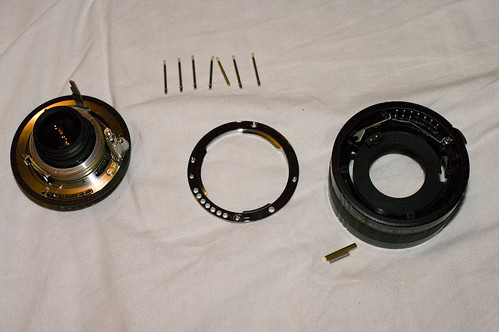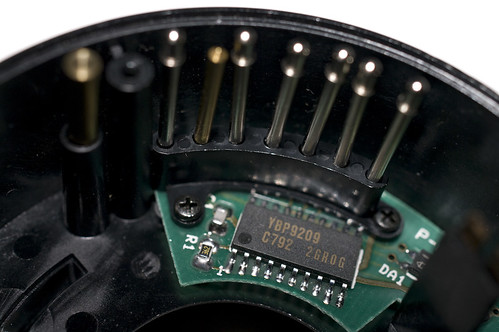If you do this, it is on your own risk. Taking appart lenses, especially a simple thing as a converter, is relatively easy. Putting them together is hard. Takes patience and steady fingers.
The Kenko converter is plastic, though all important pieces are metal. But not the best metal. Use good screwdrivers of a good fit when you take it apart. The screws that keep the bayonets in place were quite soft.

Be careful because there are plenty of loose pieces in there, including some very small springs. Work over a surface where you can find small pieces that goes their own way.
This is what it looks like after the first step:

In the piece to the right, the biggest one, the cylinder walls of the converter, you can still see the 7 electrical contacts that transfer lens information to the camera. On the blanket you see the 7 contacts from the other end of the converter. Note that one is slightly shorter, and that you must keep track of its position if you want to be able to make it work properly again. Note the small springs sitting on the contacts (upward in the photo). They get lose easily. Take care.
The MC4 and MC7 KA converters I have taken apart before, without any autofocus, there were similar contacts on both sides which were joint in the middle with one or two springs. They transferred any electrical signal straight through the converter. For KA lenses and cameras it was enough to let the converter connect every contact on the camera with the contacts/surface or plastic isolated surface on the lens mount. The construction here is not as simple. Something is in between!

Here I have turned the piece that was to the right in the first picture upside down and replaced the seven contacts (note the "gold" colored, it is the shorter one).
As you can see, they rest (on their springs) on an electronic circuit instead of connecting directly to the contacts on the other side. Another screwdriver and here we go...

Here is the bad guy! Each contact rest on a spring which rest on one of the electronic circuit contacts A to G. Then on the other side, the same thing again. So the circuit board are positions between two lines of springs. However, the signal does not go straight through any longer. The G position is the one
Bojidar Dimitrov call the digital info contact. It transfer most of the info on aperture focal length, lens type, focus distance etc from the modern lenses to the modern cameras. The lenses also has a circuit inside it, sending all this info to the camera and receiving info (on as "secret" format).
But here Kenko have its own circuit which obviously tries to modify this signal. The only reason I can think of is that they have tried to make the converter modify the lens to camera signal considering focal length and aperture. Great idea! But it did not work! Instead the SDM lenses are totally dead considering autofocus.
Have any of the lucky owners taken a look in their Tamron 1.4x or Kenko 1.5x, converters that work with SDM? Is there also a circuit? Does these converters modify the aperture and focal length from the lens to the camera?
What to do now? Well I want this converter to do SDM on my DA*50-135 and I have some plans and options...



 Similar Threads
Similar Threads 













 ). But maybe if you have a multimeter, could you try Big Daves suggestion above and just test with the resistance meter (ohm) if the contacts goes straight through without obvious modification?
). But maybe if you have a multimeter, could you try Big Daves suggestion above and just test with the resistance meter (ohm) if the contacts goes straight through without obvious modification? ), eliminating one or all except one to see what happens. To give the whole picture I will make a separate post on this when I'm done trying all options.
), eliminating one or all except one to see what happens. To give the whole picture I will make a separate post on this when I'm done trying all options.













